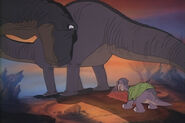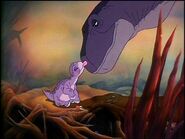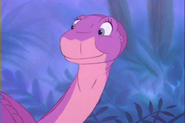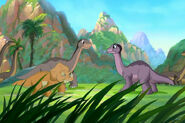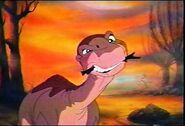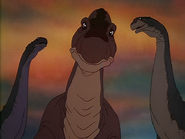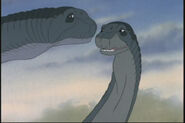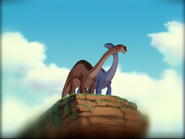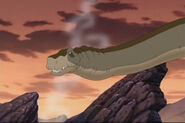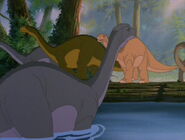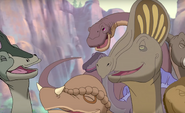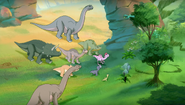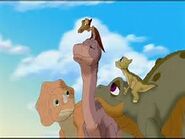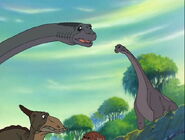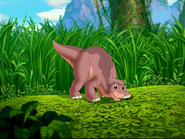Apatosaurus (/əˌpætɵˈsɔrəs/) is a genus of sauropod dinosaurs that lived about 150 million years ago, during the Jurassic Period (Kimmeridgian and Tithonian ages). It was one of the largest land animals that ever existed, with an average length of 23 m (75 ft) and a mass of at least 23 metric tons (25 short tons). The name Apatosaurus means 'deceptive lizard', so-given because the chevron bones were similar to those of a prehistoric marine lizard, Mosasaurus. The composite term Apatosaurus comes from the Greek names apate (ἀπάτη/apatelos ἀπατηλός) meaning "deception"/"deceptive" and sauros (σαῦρος) meaning "lizard".
The cervical vertebrae were less elongated and more heavily constructed than those of Diplodocus and the bones of the leg were much stockier (despite being longer), implying a more robust animal. The tail was held above the ground during normal locomotion. Like most sauropods, Apatosaurus had only a single large claw on each forelimb, with the first three toes on the hind limb possessing claws.
Fossils of Apatosaurus have been found in the Nine Mile Quarry and Bone Cabin Quarry in Wyoming and at sites in Colorado, Oklahoma and Utah, present in stratigraphic zones 2-6.[1]
Description
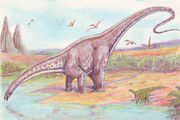
Life restoration of Apatosaurus
Apatosaurus was a large, long-necked quadrupedal animal with a long whip-like tail. Its forelimbs were slightly shorter than its hindlimbs. One measurement places the total length of Apatosaurus at 26 meters (85 ft) and its weight at 24-32 tons, roughly the weight of four elephants.[2]
The skull was small in proportion to the size of the animal. The jaws were lined with spatulate teeth, which resembled chisels, suited to a herbivorous diet.
Classification
Apatosaurus is a member of the family Diplodocidae, a clade of gigantic sauropod dinosaurs. The family includes some of the longest creatures ever to walk the earth, including Diplodocus, Supersaurus, Suuwassea, and Barosaurus. Within the subfamily Apatosaurinae, Apatosaurus may be most closely related to Suuwassea, Supersaurus and Brontosaurus.[3][4][5]
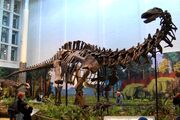
Apatosaurus louisae skeleton, Carnegie Museum
In 1877, Othniel Charles Marsh published the name of the holotype species Apatosaurus ajax, which he called after the hero Ajax from Greek mythology. Since then, two partial skeletons of A. ajax have been found, including part of a skull. He followed this in 1879 with a description of another, more complete specimen, which he thought represented a new genus and named Brontosaurus excelsus. In 1903, Elmer Riggs decided that Brontosaurus excelsus was so similar to Apatosaurus ajax that it belonged in the same genus. Riggs then re-classified the species as Apatosaurus excelsus. According to the rules of the ICZN (which governs the scientific names of animals), the name Apatosaurus, having been published first, had priority as the official name; Brontosaurus was a junior synonym and therefore discarded from formal use.
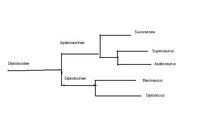
Cladogram of the Diplodocidae after Lovelace, Hartman, and Wahl, 2008.[5]
Apatosaurus excelsus is known from six partial skeletons, including part of a skull, which have been found in the United States, in Colorado, Oklahoma, Utah, and Wyoming. Apatosaurus louisae was named by William Holland in 1915 in honor of Mrs. Louise Carnegie, wife of Andrew Carnegie who funded field research to find complete dinosaur skeletons in the American West. Apatosaurus louisae is known from one partial skeleton which was found in Colorado in the United States. Apatosaurus parvus was originally known as Elosaurus parvus, but was reclassified as a species of Apatosaurus in 1994.[6] This synonymy was upheld in 2004.[7]
Apatosaurus yahnahpin was named by Filla and Redman in 1994. Robert T. Bakker made A. yahnahpin the type species of a new genus, Eobrontosaurus in 1998,[8] so it is now properly Eobrontosaurus yahnahpin.
History

1896 diagram of the Brontosaurus excelsus skeleton by O.C. Marsh. The head is based on material now assigned to Brachiosaurus sp.[9]
Othniel Charles Marsh, a Professor of Paleontology at Yale University, described and named an incomplete juvenile skeleton of Apatosaurus ajax in 1877. Two years later, Marsh announced the discovery of a larger and more complete specimen at Como Bluff, Wyoming — which, because of discrepancies including the size difference, Marsh misidentified as belonging to an entirely new genus and species. He dubbed the new species Brontosaurus excelsus, meaning "thunder lizard", from the ancient Greek brontē/βροντη meaning 'thunder' and sauros/σαυρος meaning 'lizard', and from the Latin excelsus, "to exceed in number", referring to the greater number of sacral vertebrae than in any other genus of sauropod known at the time.
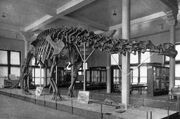
Original Apatosaurus excelsus skeletal mount at the AMNH. This mount is now considered to be outdated.
The finds, representing the largest dinosaur discovered at the time, were nearly complete, lacking only a head, feet, and portions of the tail. They were then prepared for what was to be the first ever mounted display of a sauropod skeleton, at Yale's Peabody Museum of Natural History in 1905. The missing bones were created using pieces from known close relatives of Brontosaurus. Sauropod feet that were discovered at the same quarry were added, as well as a tail fashioned to appear as Marsh believed it should, and a composite model of what he felt the skull of this massive creature might look like. This was not a delicate Diplodocus-style skull, which would later turn out to be more accurate,[10]), but was composed of "the biggest, thickest, strongest skull bones, lower jaws and tooth crowns from three different quarries",[11] consisting primarily of those of Camarasaurus, the only other sauropod for which good skull material was known at the time. This method of reconstructing incomplete skeletons based on the more complete remains of related dinosaurs continues in museum mounts and life restorations to-date.
Despite the much-publicized debut of the mounted skeleton, which cemented the name Brontosaurus in the public consciousness, Elmer Riggs had published a paper in the 1903 edition of Geological Series of the Field Columbian Museum which argued that Brontosaurus was not different enough from Apatosaurus to warrant its own genus, and created the combination Apatosaurus excelsus: "In view of these facts the two genera may be regarded as synonymous. As the term 'Apatosaurus' has priority, 'Brontosaurus' will be regarded as a synonym."
Despite this, at least one paleontologist—Robert Bakker—argued in the 1990s that A. ajax and A. excelsus are in fact sufficiently distinct that the latter continues to merit a separate genus.[12] In 2015 Emanuel Tschopp, Octávio Mateus, and Roger Benson released a paper that argued that Apatosaurus excelsus, originally classified as Brontosaurus excelsus, had enough morphological differences from other species of Apatosaurus that it warranted being reclassified as a separate genus again. The conclusion was based on a comparison of 477 morphological characteristics across 81 different dinosaurs. Among the many notable differences were the wider - and presumably stronger - neck of other Apatosaurus species compared to A. excelsus. Other species previously assigned to Apatosaurus, such as Elosaurus parvus and Eobrontosaurus yahnahpin were also reclassified as Brontosaurus. However, some are skeptical of the large number of sauropod taxa in the Morrison, instead grouping taxa like Brontosaurus and Apatosaurus together.[13]
Palaeobiology
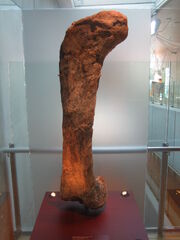
Apatosaurus femur in Cosmocaixa, Barcelona
Early on, it was believed that Apatosaurus was too massive to support its own weight on dry land, so it was theorized that the sauropod must have lived partly submerged in water, perhaps in a swamp, but recent findings do not support this. In fact, like its relative Diplodocus, Apatosaurus was a grazing animal with a very long neck and a long tail that served as a counterweight. One study found that diplodocid necks were less flexible than previously believed, and that sauropods like Apatosaurus were adapted to low browsing or ground feeding.[14]
In 2008, footprints of juvenile Apatosaurus were reported from Quarry Five in Morrison, Colorado. Discovered in 2006 by Matthew Mossbrucker, these footprints show that juveniles could run on their hind legs in a manner similar to that of the modern basilisk lizard.[15]
Posture
In the early 20th century, diplodocids like Apatosaurus were often portrayed with their necks held high up in the air, allowing them to graze from tall trees. More recently, scientists have argued that the heart would have had trouble sustaining sufficient blood pressure to oxygenate the brain. Furthermore, more recent studies have shown that the structure of the neck vertebrae would not have permitted the neck to bend far upwards.[16][17] However, subsequent studies demonstrated that all tetrapods appear to hold their necks at the maximum possible vertical extension when in a normal, alert posture, and argued that the same would hold true for sauropods barring any unknown, unique characteristics that set the soft tissue anatomy of their necks apart from other animals. Apatosaurus like Diplodocus would have held its neck at about a 45 degree angle with the head pointed downwards in a resting posture.[18]
Physiology
With Apatosaurus possessing such a large body mass, combined with a long neck, physiologists have had problems determining how the animals managed to breathe.
Beginning with the assumption that Apatosaurus, like crocodilians, did not have a diaphragm, the dead-space volume (the amount of unused air remaining in the mouth, trachea and air tubes after each breath) has been estimated at about 184 liters for a 30 ton specimen.
Its tidal volume (the amount of air moved in or out during a single breath) has been calculated based on the following respiratory systems:
- 904 liters if avian
- 225 liters if mammalian
- 19 liters if reptilian.
On this basis, its respiratory system could not have been reptilian, as its tidal volume would not have been able to replace its dead-space volume. Likewise, the mammalian system would only provide a fraction of new air on each breath. Therefore, it must have had either a system unknown to modern science or an avian system, i.e. multiple air sacs and a flow-through lung. Furthermore, an avian system would only need a lung volume of about 600 liters compared to a mammalian requirement of 2,950 liters, which would exceed the available space. The overall thoracic volume of Apatosaurus has been estimated at 1,700 liters allowing for a 500-liter, four-chambered heart (like birds, not three-chambered like reptiles) and a 900-liter lung capacity. That would allow about 300 liters for the necessary tissue. Assuming Apatosaurus had an avian respiratory system and a reptilian resting-metabolism, it would need to consume only about 262 liters (69 gallons) of water per day.[19]
Tail
An article that appeared in the November 1997 issue of Discover Magazine reported research into the mechanics of Apatosaurus tails by Nathan Myhrvold, a computer scientist from Microsoft. Myhrvold carried out a computer simulation of the tail, which in diplodocids like Apatosaurus was a very long, tapering structure resembling a bullwhip. This computer modeling suggested that sauropods were capable of producing a whip-like cracking sound of over 200 decibels, comparable to the volume of a cannon.[20]
Cultural influence
The length of time taken for Marsh's misclassification to be brought to public notice meant that the name Brontosaurus, due to its association with one of the largest known dinosaurs, became so famous that it persisted long after the name had officially been abandoned in scientific use. The terms "brontosaurus", "brontosaurs", and "brontosaurians" are often used to refer generically to any of the sauropod dinosaurs.
In 1989, the U.S. Post Office issued four "dinosaur" stamps, featuring Tyrannosaurus, Stegosaurus, "Pteradon" (misspelling of Pteranodon), and Brontosaurus. The inclusion of these last two led to complaints of "fostering scientific illiteracy",[21] due to Pteranodon being a pterosaur and not a dinosaur, and Brontosaurus being an invalid taxon. The Post Office defended itself (in Postal Bulletin 21744) by saying, "Although now recognized by the scientific community as Apatosaurus, the name "Brontosaurus" was used for the stamp because it is more familiar to the general population." Stephen Jay Gould supported this position in his essay "Bully for Brontosaurus", though he echoed Riggs' original argument that "Brontosaurus" is a synonym for "Apatosaurus". Nevertheless, he noted that the creature has developed and continues to maintain an independent existence in the popular imagination.[22]
Brontosaurus has often been depicted in cinema; the 1925 silent film The Lost World featured, using special effects by Willis O'Brien, a battle between a Brontosaurus and an Allosaurus. The 1933 movie King Kong featured a Brontosaurus, as did the 2005 remake, described using the fictional scientific name "Brontosaurus baxteri", or Baxter's Thunder-Lizard, after a character in the film. The 1933 Brontosaurus was inaccurately portrayed as a carnivore. The brontosaur of the 2005 film is noticeably different from the modern view of Apatosaurus, with a square head, low-hanging tail, and snake-like neck reminiscent of 1930s period depictions of the species in art.
When George Lucas made his special edition of Star Wars Episode IV: A New Hope in 1997, he added some large, long-necked animals based on the Brachiosaurus digital model from Jurassic Park. At an early stage he altered the CG department's suggested name "Bronto," taken from Brontosaurus, to "Ronto".[23]
In the TV sitcom Dinosaurs, Fran's friend Monica is an Apatosaurus[24] real estate agent (shown as a bright blue neck and head, wearing a pearl necklace) voiced by Suzie Plakson.
Cabazon, California features several lifesize dinosaur sculptures, including an Apatosaurus-shaped building titled "Dinny the Dinosaur" (pronounced "Dine-ee").
Apatosaurus in The Land Before Time
Many characters in The Land Before Time are Apatosaurus. Apatosaurus is one of many dinosaur genera, namely in the sauropod order, referred to as "Longnecks" by the characters, referring to their characteristic physical trademark. Examples of Apatosaurus in the series include the main protagonist Littlefoot, his mother, his father, and his grandparents. Others include Littlefoot's distant cousin Ali, her mother, and the herd to which they belong, led by the matriarch known as the Old One.
Although these characters are consistently identified in official material as Apatosaurus, some fans and reviewers of the series have noted that they more closely resemble the related species Camarasaurus (although Camarasauruses can be seen as background characters too). Their color scheme is a simple brown, purple or gray sometimes even cream yellow or a mauve color, all Apatosaurus when young and when at their adult size have diamond-shaped blotches on their backs, which is a darker color of their uniform color. Noticbly during the ageing process in The Land Before Time universe; is that stripe on the Apatosaurus's neck extends farther to the snout once it reaches adulthood, when they grow older however they loose their diamond-shaped blotches on their backs and the stripe on their necks have greatly reduced.
Gallery
References
- ↑ Foster, J. (2007). "Appendix." Jurassic West: The Dinosaurs of the Morrison Formation and Their World. Indiana University Press. pp. 327-329.
- ↑ Holtz, Thomas R. Jr. (2008) Dinosaurs: The Most Complete, Up-to-Date Encyclopedia for Dinosaur Lovers of All Ages Supplementary Information
- ↑ Taylor, M.P. and Naish, D. (2005). "The phylogenetic taxonomy of Diplodocoidea (Dinosauria: Sauropoda)." PaleoBios, 25(2): 1–7. (download here)
- ↑ Harris, J.D. (2006). "The significance of Suuwassea emiliae (Dinosauria: Sauropoda) for flagellicaudatan intrarelationships and evolution." Journal of Systematic Palaeontology, 4(2): 185–198.
- ↑ 5.0 5.1 Lovelace, David M. (2007). "Morphology of a specimen of Supersaurus (Dinosauria, Sauropoda) from the Morrison Formation of Wyoming, and a re-evaluation of diplodocid phylogeny". Arquivos do Museu Nacional 65 (4): 527–544.
- ↑ Carpenter, K. and McIntosh, J. (1994). "Upper Jurassic sauropod babies from the Morrison Formation", In: K. Carpenter, K. F. Hirsch, and J. R. Horner (eds.), Dinosaur Eggs and Babies. Cambridge University Press, Cambridge 265–278
- ↑ Upchurch, Paul; Tomida, Yukimitsu; and Barrett, Paul M. (2004). "A new specimen of Apatosaurus ajax (Sauropoda: Diplodocidae) from the Morrison Formation (Upper Jurassic) of Wyoming, USA." National Science Museum monographs 26: i-118 ISSN:13429574
- ↑ Bakker, R.T. (1998). "Dinosaur mid-life crisis: the Jurassic-Cretaceous transition in Wyoming and Colorado". In: S.G. Lucas, J.I. Kirkland, & J.W. Estep (eds.) Lower and Middle Cretaceous Terrestrial Ecosystems; New Mexico Museum of Natural History and Science Bulletin, 14: 67–77.
- ↑ Carpenter, Kenneth; Tidwell, Virginia (1998). "Preliminary Description of a Brachiosaurus Skull from Felch Quarry 1, Garden Park, Colorado". in Carpenter, Kenneth; Chure, Dan; Kirkland, James Ian. The Upper Jurassic Morrison Formation: an interdisciplinary study. Taylor & Francis. ISBN 9056991833. http://books.google.com/books?id=CLEPeg_SjTcC&pg=PA69.
- ↑ McIntosh, J.S. and Berman, D.S. (1975). "Description of the palate and lower jaw of the sauropod dinosaur Diplodocus (Reptilia: Saurischia) with remarks on the nature of the skull of Apatosaurus." Journal of Paleontology, 49(1): 187–199.
- ↑ Bakker, Robert (1994). "The Bite of the Bronto" Earth 3:(6):26–33.
- ↑ Bakker, R.T. (1998). "Dinosaur mid-life crisis: the Jurassic-Cretaceous transition in Wyoming and Colorado". In: S.G. Lucas, J.I. Kirkland, & J.W. Estep (eds.) Lower and Middle Cretaceous Terrestrial Ecosystems; New Mexico Museum of Natural History and Science Bulletin, 14: 67–77.
- ↑ Prothero, D.. "Is "Brontosaurus" Back? Not So Fast!". http://www.skeptic.com/insight/is-brontosaurus-back-not-so-fast/#comment-38531. Retrieved on 1 May 2015.
- ↑ Stevens, Kent A.; Parrish, JM (1999). "Neck Posture and Feeding Habits of Two Jurassic Sauropod Dinosaurs". Science 284 (5415): 798–800. doi:. PMID 10221910. http://www.sciencemag.org/cgi/content/abstract/284/5415/798. Retrieved on 2008-08-03.
- ↑ Rajewski, Genevieve (May 2008). "Where Dinosaurs Roamed". Smithsonian: 20–24. http://www.smithsonianmag.com/history-archaeology/phenom-dino-200805.html. Retrieved on 2008-04-30.
- ↑ Stevens KA, Parrish JM (2005). "Neck Posture, Dentition and Feeding Strategies in Jurassic Sauropod Dinosaurs". in Carpenter, Kenneth and Tidswell, Virginia (ed.). Thunder Lizards: The Sauropodomorph Dinosaurs. Indiana University Press. pp. 212–232. ISBN 0-253-34542-1. OCLC 218768170 57202057 61128849.
- ↑ Upchurch, P, et al. (2000). "Neck Posture of Sauropod Dinosaurs" (PDF). Science 287, 547b (2000); DOI: 10.1126/science.287.5453.547b. http://www.sciencemag.org/cgi/reprint/287/5453/547b.pdf. Retrieved on 2008-08-05.
- ↑ Taylor, M.P., Wedel, M.J., and Naish, D. (2009). "Head and neck posture in sauropod dinosaurs inferred from extant animals". Acta Palaeontologica Polonica 54 (2), 2009: 213-220 abstract
- ↑ Paladino, F.V., Spotila, J.R., and Dodson, P. (1997). "A Blueprint for Giants: Modeling the Physiology of Large Dinosaurs." In Farlow, J.O. and Brett-Surman, M.K. (eds.), The Complete Dinosaur, Indiana University Press, 491–504. doi0253333490.
- ↑ Zimmer, C. (1997). "Dinosaurs in Motion." Discover, 1 Nov 1997. [1] Accessed 27 Jul 2008.
- ↑ " Topics of The Times; Leapin' Lizards!" The New York Times, 1989-10-11. Last accessed 2008-06-08.
- ↑ Gould, S.J. (1991). Bully for Brontosaurus: Reflections in Natural History, W. W. Norton & Co., 540pp.
- ↑ "Ronto". Databank. Star Wars.com. http://www.starwars.com/databank/creature/ronto/index.html. Retrieved on 2009-01-13.
- ↑ "I loved Monica (always thought she was a Brontosaurus...)" personal communication from Suzie Plakson dated Jan. 4, 2010
External links
- Skeletal drawings of diplodocids including Apatosaurus ajax, B. excelsus, and A. louisae from SkeletalDrawing.com


